The Economics and Statistics Division maintains archives of previous publications for accountability purposes, but makes no updates to keep these documents current with the latest data revisions from Statistics Canada. As a result, information in older documents may not be accurate. Please exercise caution when referring to older documents. For the latest information and historical data, please contact the individual listed to the right.
<--- Return to Archive
For additional information relating to this article, please contact:
September 27, 2023NOVA SCOTIA QUARTERLY POPULATION ESTIMATES AS OF JULY 1, 2023 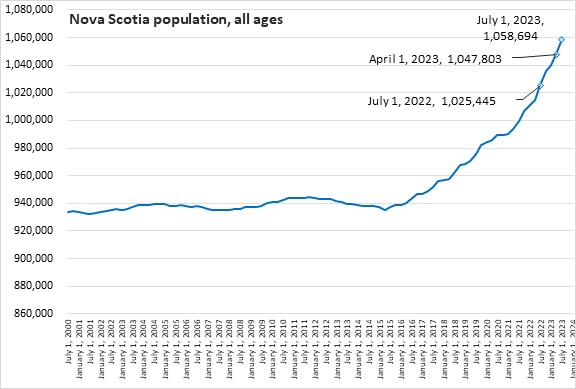
Nova Scotia's population was 1,058,694 as of July 1, 2023. Nova Scotia's population increased by 10,891 (+1.04%) from April 1, 2023.
From April 1 to June 30, there were large contributions to population growth from immigration (+2,467) and non-permanent residents (+6,177) as well as from net interprovincial migration (+2,773). Natural change (-463) continues to put downward pressure on Nova Scotia's population as deaths outpace births. Net emigration from Nova Scotia to other countries reduced the population by a further 63.
There are seasonal patterns in quarterly population changes, particularly evident in births and migration. From April 1 to June 30, 2023, Nova Scotia posted an increase above other Q1 changes.
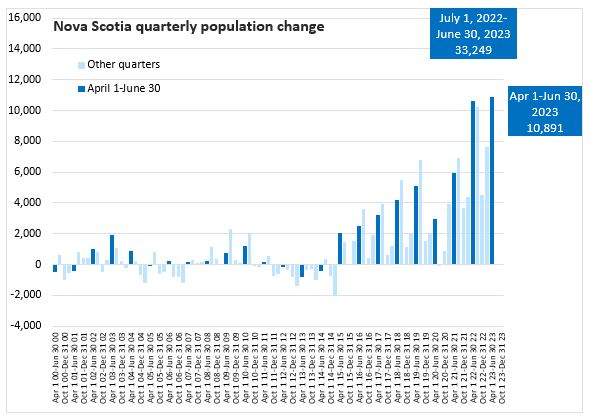
From April 1 to June 30, 2023 Nova Scotia’s population increased 1.04%, while the national population grew 0.90%. All provinces reported increasing populations. Prince Edward Island and Alberta were only provinces growing faster than Nova Scotia this quarter. Newfoundland and Labrador had the slowest population growth.
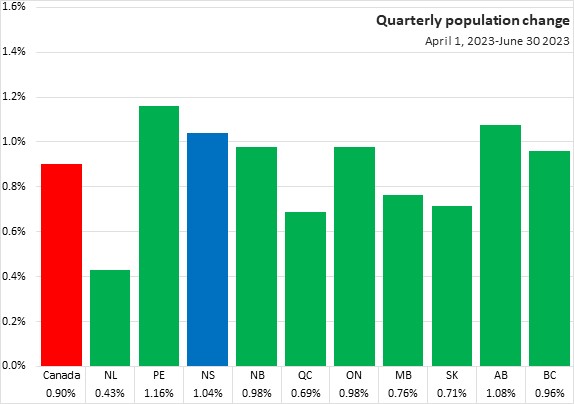
Year-over-year change
Compared with July 1, 2022, Nova Scotia's population increased by 33,249 (+3.24%). This was the second fastest year-over-year growth for Nova Scotia's population for any 12-month period of the quarterly data that started in 1951, following on the fastest growth last quarter of 3.25%. Since ending a period of population decline on April 1, 2015 Nova Scotia's population has increased by 123,314.
Contributing to population growth from July 1, 2022 were births (+8,122), immigrants (+12,303), net non-permanent residents (+15,518), and net interprovincial migration (+8,526) offset by deaths (-10,738) and net emigrants (-482).
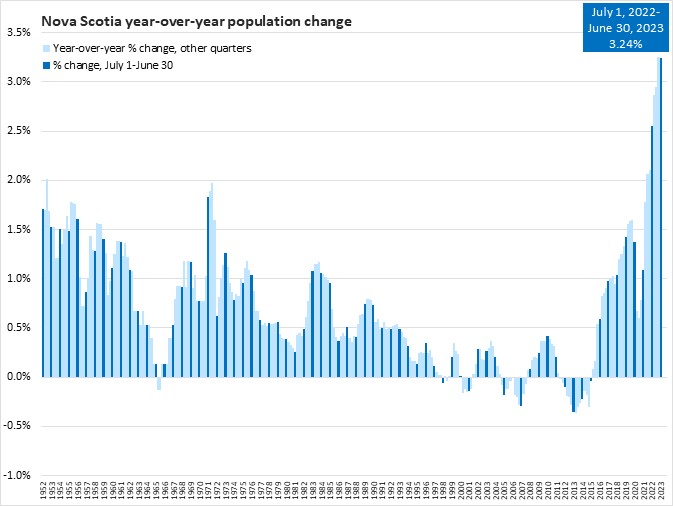
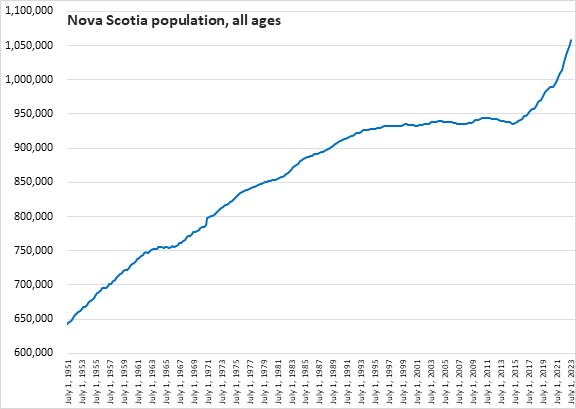
Over the previous 12 months, the national population grew by 2.98%. Nova Scotia's year-over-year population growth (+3.24%) was the third fastest after Alberta (+4.09%) and Prince Edward Island (+3.95%). Newfoundland and Labrador (+1.32%) and Quebec (+2.34%) reported the slowest growth rates.
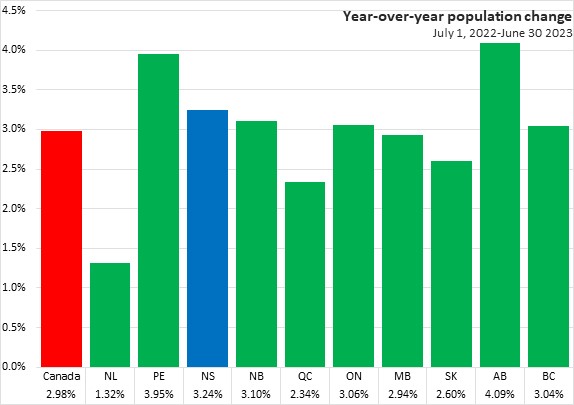
Immigration from other countries has been a strong contributor to population growth in Nova Scotia in recent years. For the period April 1 to June 30, an additional 2,467 immigrants came to the province, the second largest number for a Q2 period after the Q2 2022 increase. Over the past year, 12,303 immigrants have arrived in Nova Scotia.

The net change in non-permanent residents in the province was a net inflow of 6,177 from April 1 to June 30 coming from an 8,184 inflow and a 2,007 outflow of non-permanent residents. This was the largest net increase for non-permanent residents for any recent quarter. Over the past year, non-permanent residents living in the province has increased by 15,518.

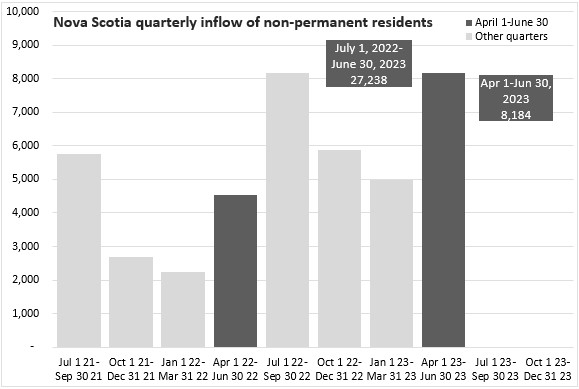

Nova Scotia’s natural population change (the number of births less the number of deaths) has been negative for several years. Between April 1 and June 30 there were 2,139 births and 2,602 deaths, amounting to a natural population decline of 463.
Since July 1, 2022, births of 8,122 were outnumbered by deaths of 10,738, resulting in a 2,616 natural population change.
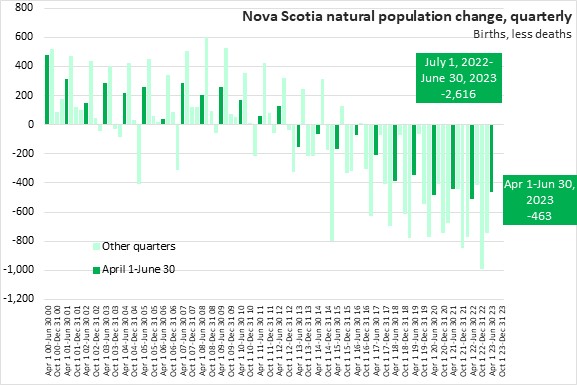
A total of 8,467 new Nova Scotians arrived in the province from other parts of Canada between April 1 and June 30. In-migration is typically strong in the spring months and has been particularly strong in recent years. Since July 1, 2022 there has been 26,189 interprovincial migrants to Nova Scotia.

A total of 5,694 Nova Scotians left the province bound for other parts of Canada between April 1 and June 30. This was the most out-migration for a quarter since April 1-June 30, 2015. Over the past year, Nova Scotia has seen 17,663 interprovincial outmigrants.
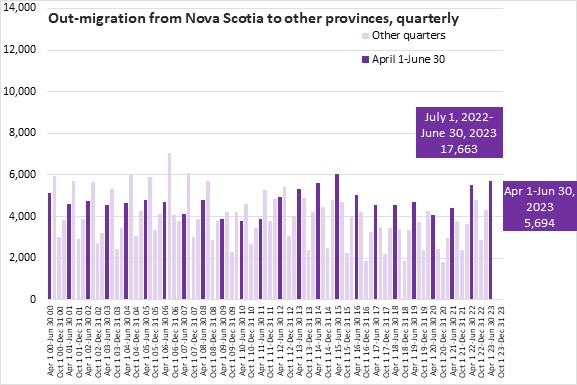
Due to net interprovincial migration, Nova Scotia's population grew by 2,773 from April 1 to June 30 and by 8,526 since July 1, 2022.
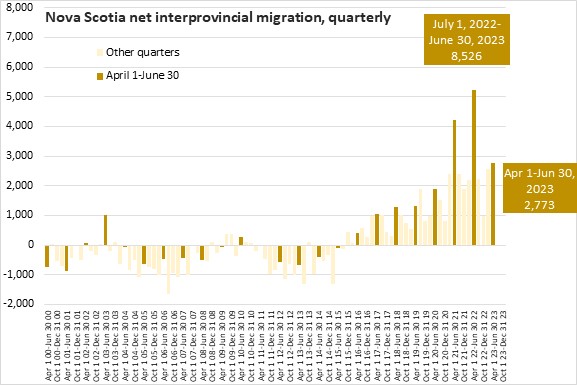
Ontario continues to account for the largest number of in-migrants to Nova Scotia. Migration from Ontario to Nova Scotia decreased from 5,770 between April 1, 2022 and June 30, 2022 to 4,282 from April 1, 2023 to June 30, 2023. In-migrants were up for New Brunswick, Yukon, and Northwest Territories while declining in the other provinces and Nunavut .
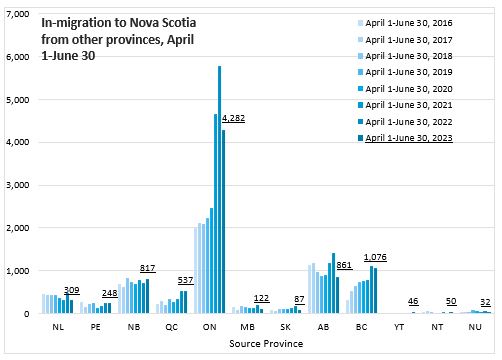
Ontario, Alberta and New Brunswick were the largest destinations for those leaving Nova Scotia between April 1 and June 30 of 2023. The largest increase in out-migration compared to Q2 2022 were to British Columbia and New Brunswick.
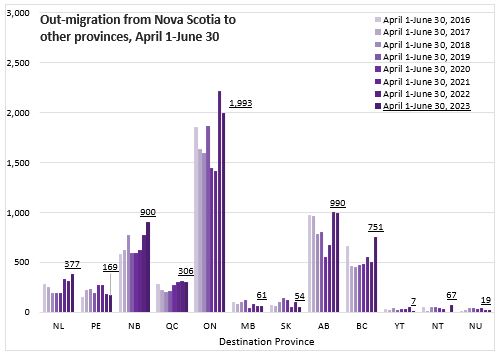
Ontario, British Columbia and Québec were the main sources of positive net interprovincial migration to Nova Scotia in Q2 2023 (with smaller contributions from Prince Edward Island, Manitoba, Saskatchewan , Yukon and Nunavut). Net interprovincial migration with Nova Scotia was negative for Alberta, New Brunswick, Newfoundland and Labrador and Northwest Territories.
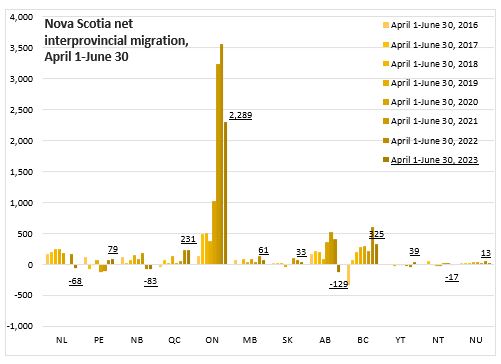
For July 1, 2022 to June 30, 2023, the largest source of interprovincial in-migration was from Ontario, although it declined from the previous year. In-migration was lower from all provinces and territories except Yukon compared to the previous year.

The primary destination for outmigration was Ontario, Alberta, and New Brunswick for the July 1, 2022 to June 30, 2023. Compared to the previous year, outmigration was lower to all provinces except Alberta that had only a minimal increase.
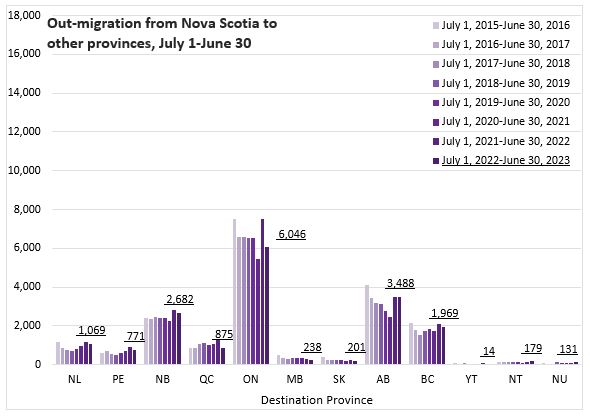
Ontario, British Columbia and Quebec were the largest sources of positive net interprovincial migration for July 1, 2022 to June 30, 2023.

Non-permanent residents
Statistics Canada has released additional information on the stock and flow of non-permanent residents in the provinces. The number of non-permanent residents in Nova Scotia has increased from 27,232 as of July 1, 2021 to 45,794 as of July 1, 2023. Non-permanent residents most often hold work permits (20,712), study permits (13,619), or both work and study permits (9,056). Asylum claimants, both with and without study/work permits, were 325 as of July 1, 2023. There were 2,082 other non-permanent residents which are generally family members living with permit holders or persons with temporary residents permits.

Non-permanent residents accounted for 4.3% of Nova Scotia's population as of July 1, 2023. Nationally, non-permanent residents make up 5.5% of the population with the highest share in British Columbia (7.3%) and Ontario (6.3%) and lowest share in Newfoundland and Labrador (2.4%) and Saskatchewan (2.5%).
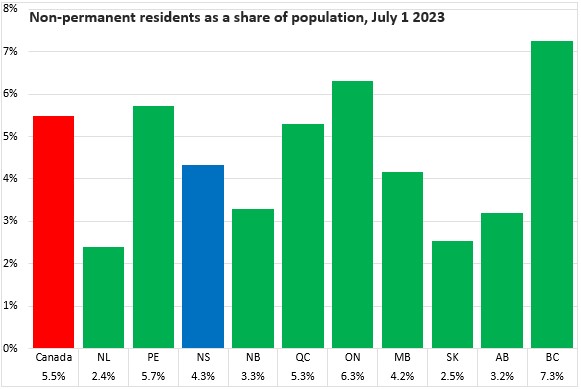
For the period April 1, 2023 to July 1, 2023, non-permanent resident population in Nova Scotia grew 15.6%, the fastest among the provinces. Nationally, the non-permanent resident population was up 11.9% with the slowest growth in Prince Edward Island.
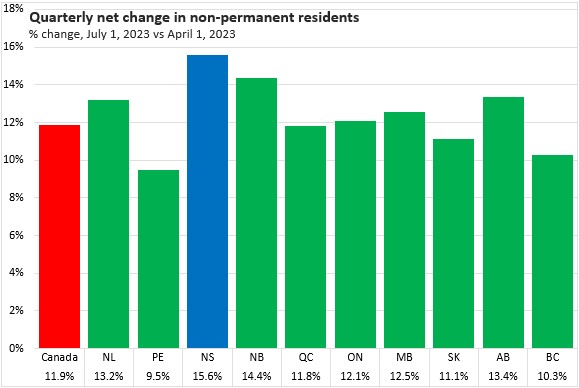
The non-permanent resident population in Nova Scotia has increased 51.3% since July 1, 2022. Nationally, the non-permanent resident population increased 46.5% with the fastest growth in Alberta and the slowest in Prince Edward Island.
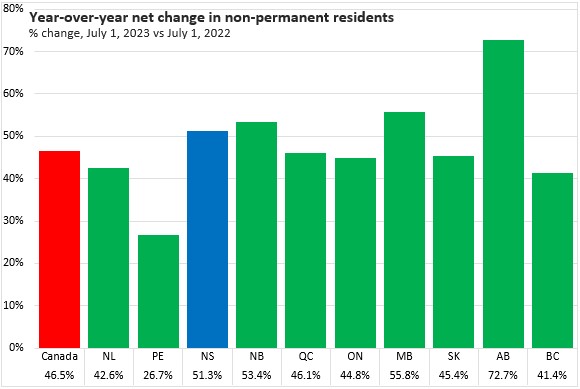
Source: Statistics Canada. Table 17-10-0009-01 Population estimates, quarterly; Table 17-10-0020-01 Estimates of the components of interprovincial migration, quarterly; Table 17-10-0040-01 Estimates of the components of international migration, quarterly; Table 17-10-0045-01 Estimates of interprovincial migrants by province or territory of origin and destination, quarterly; Table 17-10-0059-01 Estimates of the components of natural increase, quarterly; Table 17-10-0121-01 Estimates of the number of non-permanent residents by type, quarterly
<--- Return to Archive